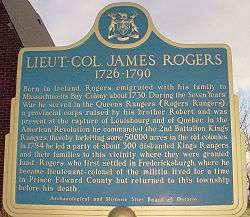James Rogers (soldier)
| James Rogers | |
|---|---|
| Born |
c. 1726 Ireland |
| Died |
September 23, 1790 Sandhurst, Ontario |
| Service/branch | British Army |
| Years of service | 1754–1783 |
| Rank | Lieutenant-Colonel |
| Unit |
Rogers' Rangers Queen's Rangers King's Rangers |
| Commands held | 2nd Battalion, King's Rangers |
| Battles/wars |
French and Indian War American War of Independence |
James Rogers (c. 1726 – September 23, 1790) was an Irish-born soldier. He emigrated to America at an early age and became a frontiersman. He served with his brother Robert Rogers during the French and Indian War. He then served as a Loyalist leader during the American War of Independence and later settled in Ontario in Canada.
Early life
Rogers was born to James and Mary Rogers in Ireland, and they immigrated to the Massachusetts Bay Colony around 1729. Robert Rogers was born in 1731 and a third brother Richard in 1733.[1] During the French and Indian War, he served in Rogers' Rangers, a provincial Ranger Corps raised by his brother Robert Rogers.
French and Indian War
He was with Robert in the Battle on Snowshoes in January 1757,[2] the Siege of Louisbourg (1758), the Ile Saint-Jean Campaign and the Battle of the Plains of Abraham (1759).[3] In 1765, he was granted the township of Kent, a 26,000-acre (110 km2) parcel in Vermont later known as the townships of Londonderry and Windham.
American War of Independence
In the American War of Independence, he commanded the 2nd Battalion of the King's Rangers, thereby forfeiting his lands in Vermont. In 1784, he led a party of about 300 disbanded King's Rangers and their families to the Third Township of Cataraqui, later known as the Township of Fredericksburgh, in Lennox County, Ontario, where they were granted land.[4] Rogers, who first settled in Fredericksburgh, where he became lieutenant-colonel of the militia, lived for a time in Prince Edward County, Ontario but returned to Fredericksburgh before his death on September 23, 1790.[3]
Vermont negotiations
Between 1780 and 1783, Rogers was heavily involved in the negotiations with Ethan Allen and Thomas Chittenden to have Vermont come back under the British Crown.[5] Rogers and Allen were both large land owners in Vermont, which had not been admitted to the newly formed United States because both New York and New Hampshire claimed it as their own,[6] and declared independence in 1777. These negotiations resulted in Allen being accused of treason, but no formal charges were ever made.

Family and notable descendants
James married Margaret McGregor (1740–1793), daughter of Presbyterian Minister, Reverend David McGregore of Derry, New Hampshire, in March 1760. His second son, James Rogers III (1764–1841), petitioned the state of Vermont and reclaimed the townships of Londonderry in 1795 [7] and Windham in 1797.[8] His third son, David McGregor Rogers (1772–1824), assisted in the petitions and became a member of Canadian Parliament. There was another David Rogers, the first son of then Captain James Rogers, who died at 4 years old in 1766 and is buried in East Derry, New Hampshire.
Notes
- ↑ Fryer p.237
- ↑ Manchester Historic Association (N.H.) (1896), Manchester Historic Association Collections, Manchester, N.H.: Manchester Historic Association, pp. 104–105, retrieved 2008-04-10
- 1 2 "Plaque in Sandhurst, Greater Napanee, Ontario". Ontario's Historical Plaques. May 28, 2004. Retrieved 2008-04-10.
- ↑ South Fredericksburgh Heritage Website
- ↑ A History of the King's Rangers
- ↑ Vermont/New York Boundary History
- ↑ E.P. Walton, ed. (1876), Records of the Governor and Council of the State of Vermont, J. & J. M. Poland, pp. 93, ISBN 978-0-404-07600-9, retrieved 2008-04-10
- ↑ Hall, Benjamin Homer (1858), History of Eastern Vermont, D. Appleton & Co., pp. 249, retrieved 2008-04-10
Further reading
- Fryer, Mary Beacock. King's Men: The Soldier Sounders of Ontario. Dundurn Press, 1980.
- Rogers, Robert J., Rising Above Circumstances: The Rogers Family In Colonial America. Sheltus & Picard, 1998. ISBN 978-0-9696296-5-8
- Hall, Benjamin Homer, History of Eastern Vermont. Appleton, 1858.
External links
- Descendants of James Rogers, Father of the Rangers. Contains descendants of Robert Rogers, James Rogers, Samuel Rogers and his other siblings.
- "The Loyalist Collection". The University of New Brunswick. March 2003. Retrieved 2008-03-27.
- Robert Rogers
- Rogers' Rangers